 To enhance service speed and avoid tariff delays, we've opened a US warehouse. All US orders ship directly from our US facility.
To enhance service speed and avoid tariff delays, we've opened a US warehouse. All US orders ship directly from our US facility.
| Cat. No. | Product Name | Field of Application | Chemical Structure |
|---|---|---|---|
| DC76153 | UAMC-4821 |
UAMC-4821 is an inhibitor for ferroptosis with an IC50 of 5.2 nM. UAMC-4821 scavenges free radicals, blocks the lipid peroxidation, inhibits ML162. Emavusertib maleate is an orally active inhibitor for IRAK4 (IC50=57 nM) and FLT3. Emavusertib maleate inhibits NF-κB and MyD88 signaling pathways, reduces the generation of pro-inflammatory cytokines like IL-6 and IL-10, thereby exhibiting anti-inflammatory and anti-proliferative activities against cancer cells, leading to cell apoptosis. Emavusertib maleate exhibits antitumor activity in mouse model.
More description
|

|
| DC76152 | Pro-GA |
Pro-GA is a γ-Glutamylcyclotransferase (GGCT) inhibitor and a cell-permeable diester-type pro-drug with anticancer activity, GGCT is a key enzyme in glutathione metabolism and is involved in the ferroptosis pathway. Pro-GA exhibits an IC50 of 57 μM against the bladder cancer cell line T24 and can be utilized in cancer research.
More description
|

|
| DC76151 | NYY-6a |
NYY-6a is a Ferroptosis inhibitor. NYY-6a shows significant inhibitory activity against RSL3-induced ferroptosis across 786-O and HT-1080 cells with EC50s of 52 and 50 nM, respectively. NYY-6a functions as a radical trapping antioxidant (RTA) with efficacy of diminishing lipid peroxidation comparable to ferrostatin-1 and liproxtatin-1. NYY-6a is potential for ferroptosis related pathologies reasearch.
More description
|

|
| DC76150 | Ferroptosis inducer-7 |
Ferroptosis inducer-7 is an orally active and selective ferroptosis inducer via inositol 1,4,5-trisphosphate receptor (IP3R)/calcium release-activated calcium channel protein (ORAI). Ferroptosis inducer-7 exhibits a notable effect in alleviating anemia symptoms, suppressing bone marrow CTLs activation, and improving hematopoietic function in immune-mediated bone marrow failure. Ferroptosis inducer-7 can be studied in research for aplastic anemia.
More description
|

|
| DC76149 | Ferroptocide |
Ferroptocide is a cell death inducer that triggers ferroptosis and has anti-tumor activity. Ferroptocide can induce oxidative stress, leading to G2/M cell cycle arrest and apoptosis activation in LNCaP cells, while also effectively inhibiting the cell viability of both LNCaP and TRAMP-C1 cells. Ferroptocide can be used to study its capability to induce mitochondrial autophagy and to trigger immunogenic cell death (ICD) in prostate cancer cells.
More description
|

|
| DC76148 | FerroLOXIN-1 |
FerroLOXIN-1 is a potent inhibitor of 15LOX-2 that selectively blocked production of pro-ferroptotic HOO-ETE-PE and protected against RSL3-induced ferroptosis. FerroLOXIN-1 closely interacted therein with 15LOX-2 only, and in particular with Y154, N155, W158.
More description
|

|
| DC76147 | CT-1 |
CT-1 is a derivative of Cryptotanshinone. CT-1 is a ferroptosis inducer. CT-1 promotes the interaction between NCOA4 and ferritin by targeting FTH1, triggering ferritinophagy-mediated ferroptosis. CT-1 has anticancer activity against triple-negative breast cancer (TNBC). CT-1 induces ferroptosis in both N2-type tumor-associated neutrophils (TANs) and TNBC cancer cells.
More description
|

|
| DC10839 | CIL56(CA3) Featured |
CIL56 is a small molecule that induces cellular ferroptosis through production of iron-dependent reactive oxygen species (ROS).
More description
|

|
| DC74585 | N6F11 Featured |
N6F11 is a ferroptosis inducer, and can trigger the degradation of glutathione peroxidase 4 (GPX4) specifically in cancer cells. N6F11 can be used for ferroptosis study.
More description
|

|
| DC44907 | SRS11-92 Featured |
SRS11-92, a Ferrostatin-1 (Fer-1) analogue, is a potent ferroptosis inhibitor. SRS11-92 inhibits ferroptotic cell death induced by Erastin in HT-1080 human fibrosarcoma cells (EC50=6 nM).
More description
|
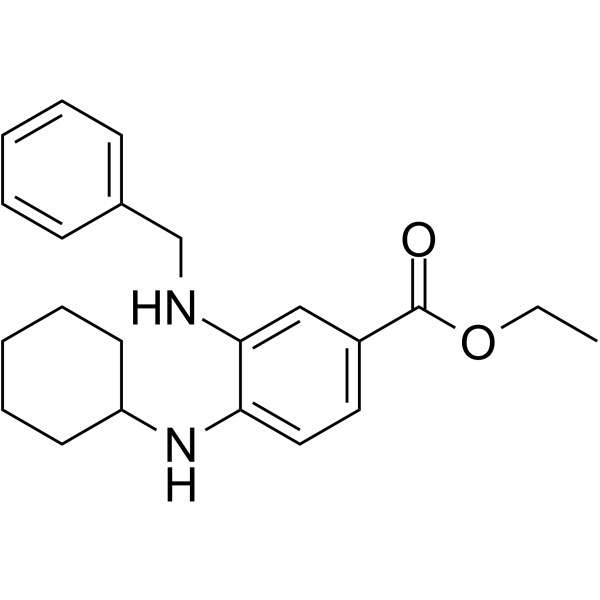
|
| DC73112 | LOC1886 |
LOC1886 is a small molecule allosteric inhibitor of GPX4, inhibits enzymatic activity of GPX4 in HT1080 cell lysates with Ki of 102 uM, degrades GPX4 to induce ferroptosis, binds covalently to C66 of GPX4.
More description
|

|
| DC73111 | FSEN1 |
FSEN1 (Ferroptosis Sensitizer 1) is a specific small molecule, uncompetitive inhibitor of ferroptosis suppressor protein 1 (FSP1) with IC50 of 133 nM, sensitizes cancer cells to ferroptosis.
More description
|

|
| DC73110 | AKI-02 |
AKI-02 is a hydroxypyridinone-based iron chelator, potently inhibits labile iron-mediated ferroptosis.
More description
|

|
| DC49170 | Erastin2 Featured |
Erastin 2(Erastin-2)is a ferroptosis inducer and a potent, selective inhibitor of the system xc(-) cystine/glutamate transporter.
More description
|
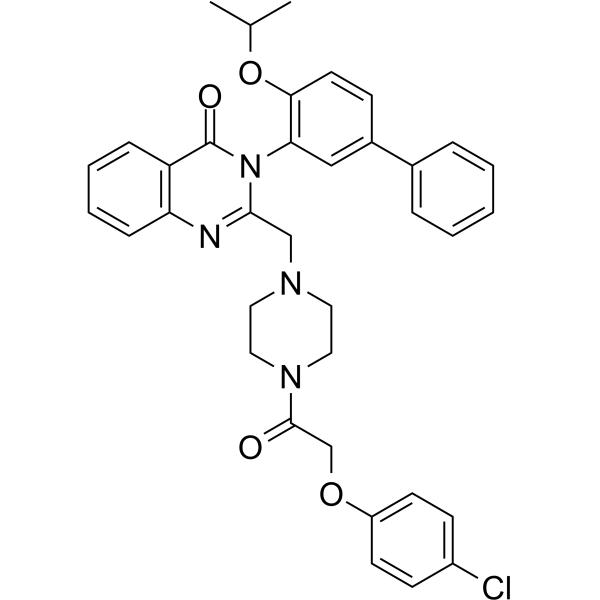
|
| DC72304 | MMRi62 Featured |
MMRi62, a ferroptosis inducer targeting MDM2-MDM4 (negative regulators of tumor suppressor p53). MMRi62 shows a P53-independent pro-apoptotic activity against pancreatic ductal adenocarcinoma (PDAC) cells and induce autophagy. MMRi62 inducesferroptosis, resulting in a increase of reactive oxygen and lysosomal degradation of ferritin heavy chain (FTH1). MMRi62 also leads to proteasomal degradation of mutant p53, also inhibits orthotopic xenograft PDAC mouse model in vivo with high frequency mutation characteristics of KRAS and TP53.12.
More description
|
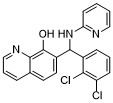
|
| DC72585 | YL-939 |
YL-939 is a potent ferroptosis inhibitor. YL-939 inhibits ferroptosis by targeting the PHB2/ferritin/iron axis.
More description
|

|
| DC9746 | RSL3 Featured |
RSL3 is a ferroptosis activator in a VDAC-independent manner,exhibiting selectivity for tumor cells bearing oncogenic RAS.
More description
|
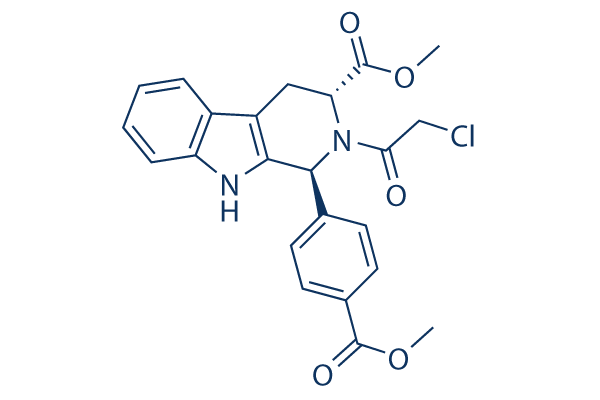
|
| DC7920 | Liproxstatin-1 Featured |
Liproxstatin-1 is able to suppress ferroptosis in cells, in Gpx4(-/-) mice, and in a pre-clinical model of ischaemia/reperfusion-induced hepatic damage.
More description
|

|
| DC10522 | FIN56 Featured |
FIN56 is a specific inducer of ferroptosis.
More description
|
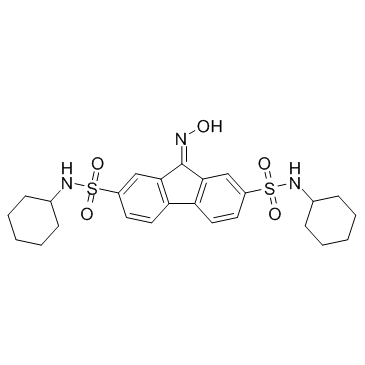
|
| DC10742 | Ferrostatin-1 (Fer-1) Featured |
Ferrostatin-1 is a selective inhibitor of erastin induced ferroptosis with EC50 value of 60 nM.
More description
|

|
| DC72305 | FA16 |
FA16 is a specific Ferroptosis inducer (IC50=1.26 μM; HT1080 cells) with metabolic stability, is the derivate of 2-(trifluoromethyl)benzimidazole. FA16 acts by inhibiting cystine/glutamate antiporter (system Xc-), which mediates the exchange of intracellular glutamate and extracellular cystine. FA16 significantly inhibits tumor growth in the HepG2 xenograft model.
More description
|

|
| DC72015 | BCP-T.A |
BCP-T.A, a tunable heterocyclic electrophile, is a potent ferroptosis inducer by binding to GPX4.
More description
|

|
| DC71728 | PAA5 |
PAA5 is a methide carbon-centered polynuclear Au(I) cluster. PAA5 can release Au(I) causing Pro-oxidant response and accelerated ferroptosis. PAA5 increases the expression of pH2AX in a time-dependent manner. PAA5 has anticancer activity.
More description
|

|
| DC70660 | NPD4928 |
NPD4928 (NPD 4928) is a small molecule that enhances ferroptosis via inhibition of ferroptosis suppressor protein 1 (FSP1).NPD4928 enhanced the sensitivity of various cancer cells to GPX4 inhibitor RSL3.
More description
|

|
| DC70504 | iHPCAL1 |
iHPCAL1 is a ferroptosis inhibitor that effectively inhibits RSL3-induced cell death, directly interacts with HPCAL1 and significantly inhibits HPCAL1 protein expression at 1.25-5 uM in HT-1080 and Calu-1 cells.iHPCAL1 delayed thermal-induced HPCAL1 protein degradation in cellular thermal shift assays (CETSAs), failed to affect the phosphorylation of PRKCQ, but inhibited the phosphorylation of HPCAL1 as well as the autophagic degradation of CDH2 induced by RSL3.The suppression of HPCAL1 phosphorylation and function induced by iHPCAL1 occurs downstream of PRKCQ phosphorylation.Bortezomib, but not chloroquine, prevented iHPCAL1-induced HPCAL1 protein degradation, iHPCAL1 stimulates the degradation of HPCAL1 through the proteasome pathway, thereby limiting ferroptosis.iHPCAL1 inhibited the anticancer activity of Imidazole ketone erastin (IKE) in a xenograft tumor model after inoculating HT-1080 cells into athymic nude mice or in an orthotopic pancreatic tumor model in which KPC cells, with no significant effect on IKE-induced GPX4 degradation in the xenograft tumor model.iHPCAL1 (10 mg/kg) protects against ferroptosis-associated acute pancreatitis in mice.
More description
|

|
| DC49532 | IM-93 |
IM-93 inhibits ferroptosis and NETosis with an IC< sub>50 of 0.45 µM for cell death inhibition.
More description
|

|
| DC39090 | iFSP1 Featured |
iFSP1 is a potent, selective and glutathione-independent inhibitor of ferroptosis suppressor protein 1 (FSP1/AIFM2) with EC50 of 103 nM. iFSP1 selectively induces ferroptosis in GPX4-knockout Pfa1 and HT1080 cells that overexpresses FSP1.
More description
|
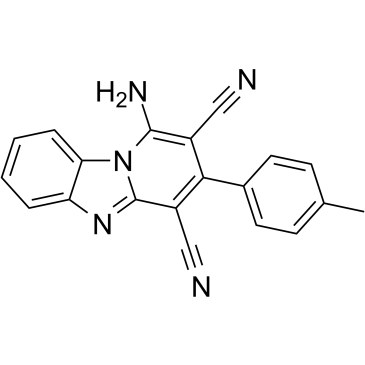
|
| DC47659 | CuATSM |
CuATSM is a highly potent radical-trapping antioxidant (RTA) and inhibitor of (phospho)lipid peroxidation, thereby accounting for its (their) ability to inhibit ferroptosis.
More description
|

|
| DC45550 | L-Buthionine-(S,R)-sulfoximine hydrochloride |
L-Buthionine-(S,R)-sulfoximine hydrochloride is a cell-permeable, potent, fast acting, orally active and irreversible inhibitor of g-glutamylcysteine synthetase and depletes cellular glutathione levels. The IC50 value of L-Buthionine-(S,R)-sulfoximine on melanoma, breast and ovarian tumor specimens are 1.9 μM, 8.6 μM, and 29 μM, respectively.
More description
|

|
| DC28803 | NBDHEX |
NBDHEX is a potent glutathione S-transferase P1-1 (GSTP1-1) inhibitor. NBDHEX induces apoptosis of tumor cells. NBDHEX acts as an anticancer agent by inhibiting GSTs catalytic activity, avoiding inconvenience of the inhibitor extrusion from the cell by specific pumps and disrupting the interaction between the GSTP1-1 and key signaling effectors. NBDHEX can also act as late-phase autophagy inhibitor.
More description
|

|